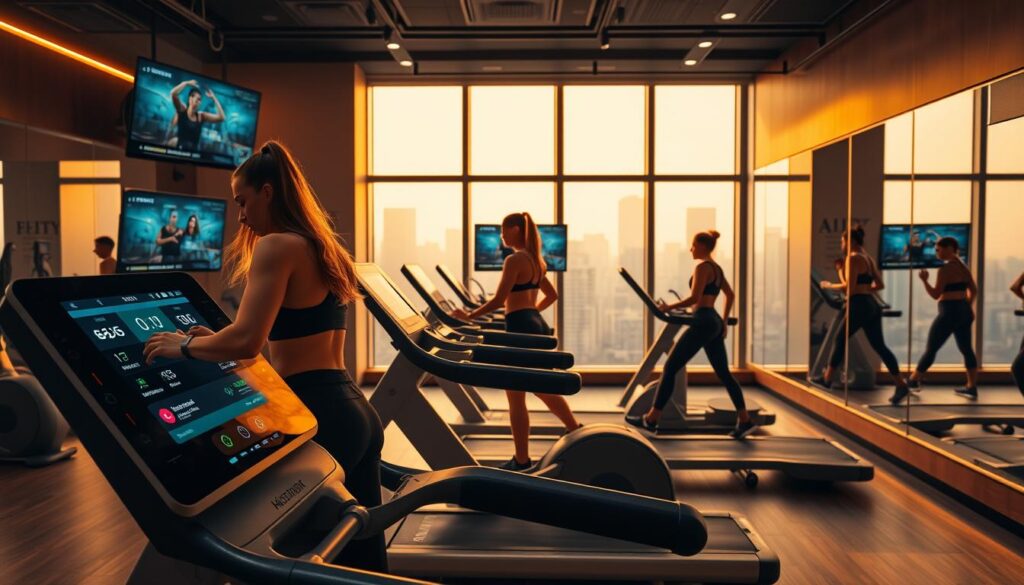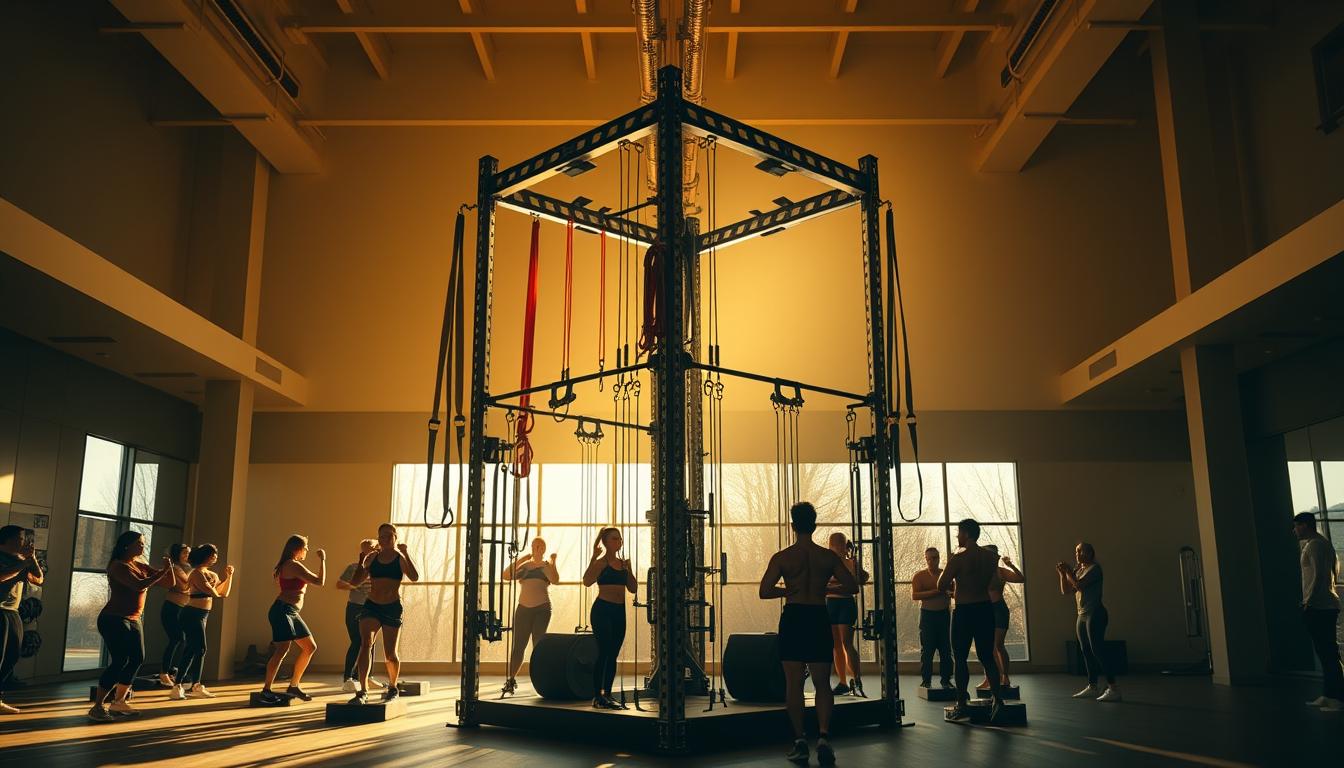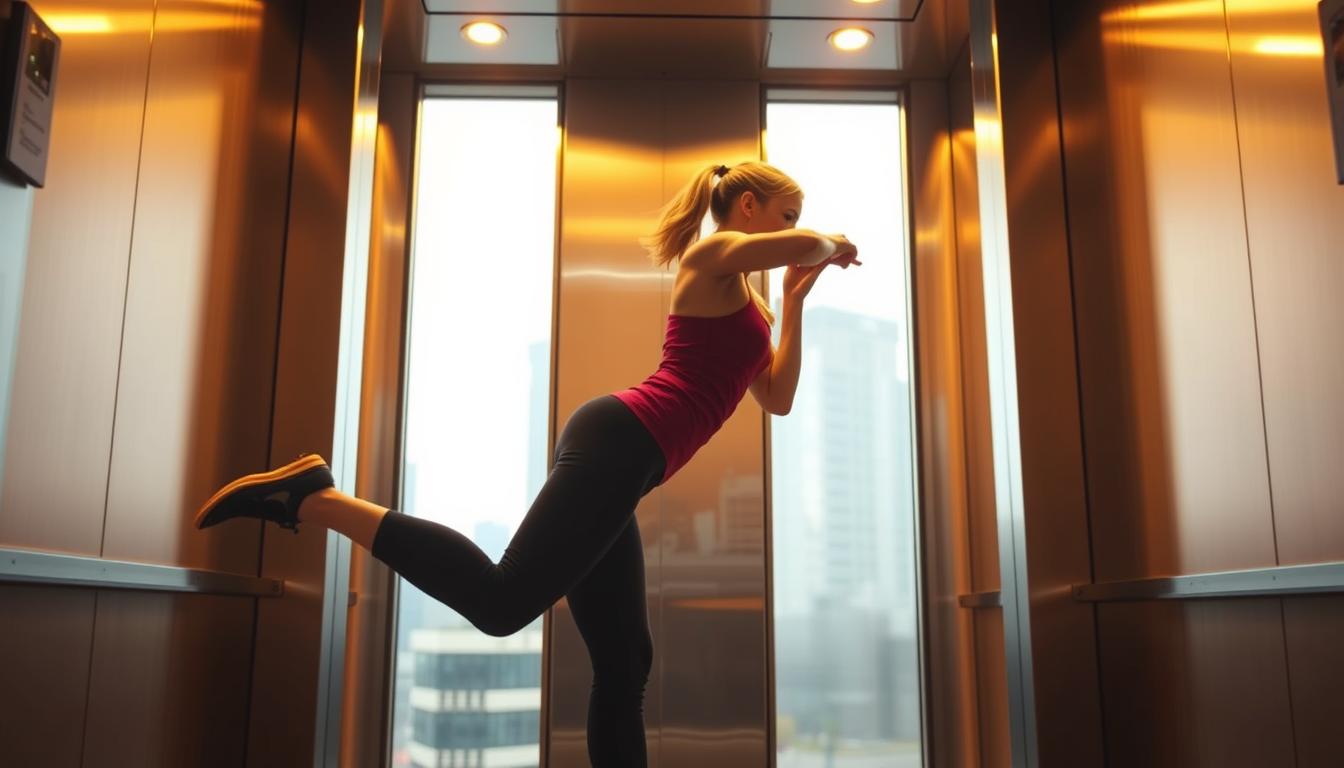Elevator fitness challenges encourage us to get moving in places like office buildings and apartments. They make exercising fun and improve our health at work and home. Adding simple exercises to our day can keep us motivated and healthy.
Did you know bad health habits can lead to higher medical bills and diseases? Taking part in elevator fitness challenges can change that. It makes workplaces happier and workers healthier. By adding exercises like taking stairs, everyone can enjoy getting fit.
Introduction to Elevator Fitness Challenges
Elevator fitness challenges offer a creative way to get people moving. Especially in places where most people sit all day. By choosing stairs over elevators, folks get more exercise. This helps them stay healthy both in body and mind.
Companies often start these challenges to make their employees healthier. These challenges are not just good for health. They also bring people together at work. Websites like Konkura help by letting people join different challenges. Here, they can share scores, comments, and pictures with others.
The Elevator Test checks if you’re strong, stable, and can move well in just a short time. You might do squats or push-ups. It’s really aimed at keeping older adults moving well so they can be independent. At first, it might be tough. But many see great progress in a few weeks. It shows how important regular exercise is.
The Importance of Staying Active in Daily Life
Staying active is key to good health. Regular activity helps with weight control, heart health, and mood. The CDC says adults need 150 minutes of exercise a week. This can be as easy as taking the stairs more often.
Exercise also improves mental health. It lowers stress and helps you sleep better. Even short activities can boost your energy for the day.
Being active boosts your confidence and improves your social life. The U.S. Department of Health and Human Services tells us every bit of movement helps. Things like gardening or dancing count as exercise and make it fun.
Adding strength training to your routine builds muscle and fitness. Mix aerobic, muscle, and balance exercises for the best health benefits. This helps keep you strong and prevents falls. Small, daily changes lead to big health improvements over time.
What Are Elevator Fitness Challenges?
Elevator fitness challenges are a way to make daily routines healthier. They encourage using stairs instead of elevators whenever you can. This boost in activity levels helps promote a health-focused lifestyle. An elevator fitness challenge might include both solo and group activities. Often, there’s tech like fitness trackers or apps to track your progress.
These challenges make your daily travel fun and focused on health. You can keep track of how often you use stairs, enjoy teamwork, and start friendly competitions. Here are some tips to get going:
- Choosing to take the stairs instead of the elevator whenever possible.
- Encouraging colleagues to join the challenge for added motivation.
- Setting up a friendly competition to see who can climb the most flights of stairs in a week.
You don’t need much to start, maybe just a strong bench for extra exercises. Participants can try different exercises like flutter kicks together with stair climbing. This fun mix of activities is a key part of staying healthy, even when you’re super busy.
Benefits of Elevator Fitness Challenges
Elevator fitness challenges make working out fun and simple while on the move. They blend fitness into your day easily and offer great benefits for your health. This means you can get both physical and mental boosts without major changes to your schedule.
Enhancing Physical Health
Elevator fitness challenges greatly improve your physical well-being. Just by taking the stairs, you get a quick and effective workout. This boosts your heart and reduces high blood pressure and bad cholesterol. Let’s look at the key benefits:
- Increased energy spent: Someone weighing 170 pounds can burn over 500 calories by stair climbing for an hour.
- Full-body workout: This activity strengthens different muscle groups, making you stronger and more enduring.
- Reduced risk of disease: Regularly taking the stairs cuts the risk of dying early by 24% and heart disease by 39%.
- Improved posture: It also makes your posture better and helps keep your joints healthy.
Improving Mental Well-Being
Moving your body has big pluses for your mental health, too. Taking part in elevator fitness challenges can make you happier and less stressed. Here are some more perks:
- Stress reduction: Stair climbing can lower stress, making you feel more calm and relaxed.
- Enhanced productivity: Being active can help you focus better and do more at work.
- Community building: Promoting stair use can strengthen bonds at work, creating a healthier environment for everyone.
Popular Elevator Fitness Challenge Ideas
Unique challenge ideas can really help boost employee engagement and build a wellness culture at work. Here are some fun ways to increase fitness and morale.
Taking the Stairs Instead
Encouraging team members to take the stairs at least once daily is a great start. You can turn it into a stair climbing contest. Set goals for how many steps to climb each day.
Keep track of everyone’s progress. Offer rewards to those who stick with it. This will keep them committed to the challenge.
Short Bursts of Exercise
Try adding quick exercises like desk workouts during breaks or while waiting for the elevator. Encourage simple moves like push-ups or squats.
This approach brings exercise into the workday. It boosts the amount of physical activity everyone gets.
Stretch and Strengthen
Set times for a quick stretch routine to help with well-being and sharpness. You can do stretching near the elevators. It’s great for preventing injuries and improving flexibility.
Creating Your Own Elevator Fitness Challenge
Designing a personal fitness challenge can make getting healthy fun and exciting. It’s about setting clear goals and getting people pumped to reach them. Here’s how to start crafting your own challenge.
Define Your Goals
The first step is to figure out what you want to achieve. Knowing why you’re doing the challenge is key. You might want to:
- Improve overall team health
- Boost morale with group activities
- Create friendly competition to get people more involved
By knowing your goals, you can inspire everyone to do their best. A clear goal makes it easier to plan activities and see how well you’re doing.
Set a Duration
Deciding how long the challenge will run is crucial. A set period makes it easier for people to join in. You could go for:
- One-week challenges for a quick start
- Two-week challenges for a bit more depth
Shorter challenges keep everyone focused and excited, without feeling too stressed. The timeframe should make the challenge fun and fit easily into daily life.
Team-Based Elevator Fitness Challenges
Team-based elevator fitness challenges can make the workplace healthier and more united. By joining a stair climb challenge, teams compete by avoiding the elevator. Prizes are given to those who use the stairs the most. This not only encourages physical activity but also makes the team spirit stronger.
To include everyone, goals must be achievable for all fitness levels. Teams can stay connected through weekly meetings. Rewards like meditation app subscriptions or ergonomic items can boost participation.
Such challenges create a strong community at work. Employees count how many stairs they climb, either daily or weekly. This encourages everyone to work together. Together, they make their workplace better and healthier.
Integrating Technology into Your Elevator Fitness Challenges
Technology has changed how we get fit, especially with elevator fitness challenges. Using fitness tracking apps and wearable tech, participants can track their progress. These tools help users reach their fitness goals by keeping them accountable and active.
Using Fitness Apps
Fitness apps are a big help for elevator fitness challenge participants. They let users set clear fitness goals. They also keep track of daily activities and steps. A study showed that after a bank introduced a digital fitness program, 43% more employees hit their activity targets each week within a month. Fitness apps help build a community, making users more competitive and engaged.
Incorporating Wearable Devices
Wearable tech, like smartwatches and trackers, play a key role in fitness today. They’re super accurate in measuring how much you move, with precision up to 99.1%. This immediate feedback boosts motivation. For instance, Conagra saw a 55% increase in employee activity minutes weekly after introducing wearables. Wearables are great for improving health, combining data tracking with goals and feedback.

Success Stories: Real-Life Elevator Fitness Challenges
Many people have taken on elevator fitness challenges with great results. One person started four months ago and saw big changes in their health. They felt much better mentally after just a week.
By completing a Lift challenge, one individual showed how much stronger and fitter they became. They worked out in a way that helped their pelvic pain go away. This improved how well their body worked. People often talk about how these challenges help with things like posture and strength in the upper body.
Those participating in the challenges feel more confident and good about themselves. They sleep better and have more toned upper bodies. For example, someone lost 27 pounds and 8% body fat by tracking their progress with InBody scans. They also lost 31.75 inches in total measurements.
The success stories tell us about clothes fitting better, less joint pain, and having more energy. Many thank the supportive community that helps them keep going with their health goals. This encouragement is key to their success.
Elevator Fitness Challenges: Boosting Workplace Wellness
Workplace wellness programs with elevator fitness challenges can make health culture better. These challenges help with physical health and bring colleagues closer. By doing fitness challenges regularly, health becomes important and part of the company’s aim.
Creating a Culture of Health
To promote health, organizations can start different fitness activities. For instance, using balance boards in meetings or taking time to stretch can cut down sitting time. This helps everyone move more during their day.
- Establish team-based fitness goals such as cumulative steps walked.
- Utilize technology like apps to track progress, fostering a sense of accountability.
- Organize weekly wellness workshops on nutrition and mental health.
- Provide resources like balance boards to support active workstations.
- Encourage opportunities for eco-friendly commuting, like walking or cycling.
Motivating Colleagues through Friendly Competition
Adding friendly competition can make the workplace more engaging and productive. By having challenges like a stairs race or step count contest, employees feel motivated and build better relationships. Celebrating wins with eco-friendly prizes adds to the fun and motivation.
- Implement “deskercise” breaks with exercises like chair squats.
- Encourage participation in local events such as 5k runs and festivals.
- Create a fitness-themed bingo game with fun activities.
- Include remote employees through virtual platforms for progress tracking.
Common Obstacles and How to Overcome Them
Working out in the elevator involves a few challenges in fitness. Sometimes, you might not feel like exercising. Regular messages can keep you motivated. Also, explaining why staying active is key can keep you engaged.
Busy schedules can make it hard to work out regularly. Having workouts at different times can help a lot. It’s also important to ensure that the stairs you use are safe.
Feeling shy about how you look can be a setback. Starting with home exercises can make you feel more at ease. Seeing your progress can make you more confident and motivated to face overcoming obstacles.
Feeling tired after work can stop you from exercising. Try working out in the morning or during lunch. Having gym clothes at work helps, too. If you’re not feeling it, setting small goals can motivate you.
Not having much money can keep you from joining a gym. But, you can work out at home or use local parks. Simply choosing stairs over elevators can increase your activity level.
If you’ve struggled with fitness before, setting realistic goals is crucial. Celebrate small wins to keep motivated. If your family isn’t supportive, find encouragement from friends or online.
Old injuries or health issues can limit your exercise. Low-impact activities, like swimming or yoga, can work well. Stress and worry can also get in the way. Adding meditation to your routine can improve your mental and physical health.
Conclusion
Elevator fitness challenges offer a great way for people to bring more activity into their busy lives. Choosing stairs over elevators leads to better health, like lower blood pressure and stronger hearts. This easy change helps burn extra calories, makes muscles stronger, and supports our joints, improving our overall health.
These challenges also boost our mental health. Climbing stairs releases endorphins, reducing stress and making us happier. It encourages us to be present in the moment, which can boost our creativity. By promoting stairs, we also help our communities by easing elevator crowding and saving energy.
By joining elevator fitness challenges, we help build a culture that values health. This benefits us, our workplaces, and our communities. As more people understand the importance of staying active, these simple steps lead to a healthier, more connected world.



